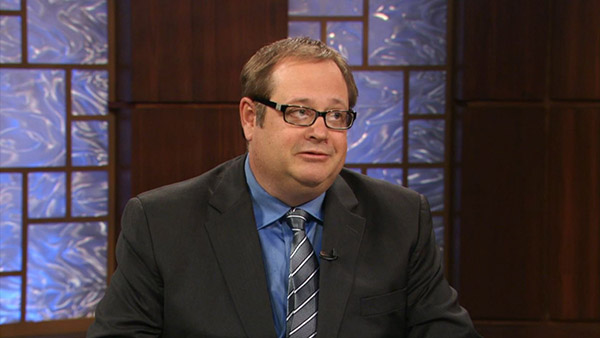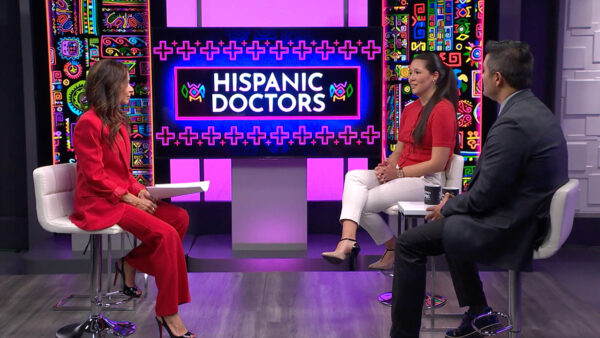Heart disease and stroke are the #1 killers of Hispanic Americans. The American Heart Association’s new campaign in the Hispanic Community promotes awareness of heart disease. Guests include: Suncerria Tillis, Director of Cultural Health Initiatives for American Heart Association, and Marilyn Perez, Co -Chair of the American Heart Association’s Cultural Health Initiatives Committee.
>> José Cárdenas:
Good evening, I'm Jose Cardenas. Welcome to "Horizonte." The controversy over Arizona's legislative boundaries is on hold, but not over. We'll have an update. Also, a new campaign is underway to promote heart disease awareness in the Hispanic community.
>> Announcer:
Funding for "Horizonte" is provided by Bank of America, who applauds those who strive for excellence. Bank of America, higher standards. And by SRP.
>> SRP's business is water and power, but our dedication to the community doesn't stop there. SRP. Delivering more than power.
>>> José Cárdenas:
Before the 2000 general election, the state legislature was responsible for redrawing the legislative and congressional district lines based on new census information. Many people believed this practice resulted in boundaries that served the politicians rather than the people of Arizona. In 2000, Arizona voters passed proposition 106 in a general election to form the Independent Redistricting Commission or IRC, to create new legislative and congressional districts. Since then, the process has been ongoing, and the debate over Arizona's legislative districts continues. In a moment, more on that. First, here's a review of Arizona's legislative redistricting milestones since 2000.
>> Reporter Merry Lucero:
Prop 106 amended the Arizona constitution to 2 create a five member nonpartisan commission to redraw congressional and legislative district boundaries, using 2000 census data. The process began with a simple population grid. Maps were put through an extensive public comment process, revised and later adopted by the IRC and submitted to the U.S. Department of Justice for preclearance under the Voting Rights Act. The DOJ objected to the Commission's 2001 adopted legislative plan, as not having enough minority voters in at least three of five legislative districts. In response, the Commission crafted an interim legislative plan, designed to increase the Hispanic voting age population in at least three of the five districts specified by the DOJ. That map was approved by federal district court and used for the 2002 election. The IRC revised the plan and submitted it to the Department of Justice which precleared it for the 2004 election. The Ariz
>> José Cárdenas:
Joining me now is Jim Huntwork, a member of the Arizona Independent Redistricting Commission. Jim, Welcome to "Horizonte." I should mention that my law firm represents the Arizona Minority Coalition, plaintiffs in one of these lawsuits. I'm not involved. Tell us what the latest is in terms of the litigation.
>> Jim Huntwork:
Well, in words of the Court of Appeals, when they stayed the trial court order, it means that we now can have an election this fall. That was actually in doubt, because of the complex legal environment that we have here in Arizona. We face both state and federal requirements, and we have to satisfy both before we can have an election. We had one set of maps that had been approved by the federal government, but was stayed by the state court, and a different set ordered by the state and hadn't been approved by the federal government. So by staying the trial court order, the Court of Appeals allowed the two things to come together so that we can have an election this fall. 4
>> José Cárdenas:
So the concern was the federal government wouldn't approve the second set of maps in time for the election?
>> Jim Huntwork:
Well, in time. The concern was that the time has already run out. Today was the deadline for candidates to file to run for office, and they had to know what districts they were going to run in.
>> José Cárdenas:
What does all of this mean for the upcoming elections?
>> Jim Huntwork:
Well, it means that the elections this fall, the legislative elections in Arizona this fall will be conducted under the commission's 2002 plan. That's the plan that was -- that we adopted in response to the Justice Department requirements, and that the trial court had enjoined.
>> José Cárdenas:
Can you kind of go back and give us an overview of the process of the creation of the commission and how we got to where we are right now?
>> Jim Huntwork:
Well, the commission was created by what I think was a very idealistic action by the people of Arizona, who wanted to take the partisanship out of the creation of the legislative districts. So they created a commission that is politically balanced. It can have only two Republicans and two Democrats, and the final member which is the chairman must be something else, an independent or another political party, but can't be either a Republican or a Democrat, and then this commission, with political balance and also geographic balance, no two of the commissioners can be from 5 the same county, for example, has been given the task of drawing these lines. The commission met and conducted extensive public hearings all over the state. I think we had over 100 public hearings. We had thousands of people who came and spoke to us directly. We had tens of thousands of people who submitted comments to us, and as a result of that process, we adopted our 2001 maps. I
>> José Cárdenas:
Candidates have an equal chance --
>> Jim Huntwork:
Statistically an equal chance of winning in those districts. But unfortunately -- I say unfortunately, those maps were disallowed by the Justice Department, and we had to go back and recreate maps that put more Hispanic voters in fewer districts, which meant basically it meant fewer competitive districts.
>> José Cárdenas:
So the maps that we're using for this next election in your opinion, are they less competitive than the ones you had originally approved in 2001?
>> Jim Huntwork:
I think they are unquestionably less -- they have to be less competitive. I don't have statistics, but because of the process, we had to take predominantly Democrat voters and put more of them into fewer districts, which simply meant, overall, that there were fewer competitive districts.
>> José Cárdenas:
The whole purpose of the legislation was to minimize partisanship. You mentioned all of the effort that the commission went through. Are you surprised at the volume of litigation that nevertheless resulted?
>> Jim Huntwork:
No, as you know, I'm also an attorney. My feeling on this was that like any important new legislation, and particularly legislation that affects people's rights in such a deep way, that this needed to be litigated. The State of Arizona won't know exactly what this means until our state Supreme Court tells us what it means, and I think I, and I think the whole commission welcomes the process that will ultimately answer those questions, and our goal is -- always has been to enforce the law as best we can, and if our interpretation of the law proves to be incorrect, we will happily and gladly redo what we did in compliance with what the Supreme Court tells us is the law in the State of Arizona.
>> José Cárdenas:
Jim, thank you for joining us on "Horizonte" to discuss this very important subject.
>> Jim Huntwork:
You bet. I appreciate it.
>> José Cárdenas:
We've been talking about the Arizona Minority Coalition for Fair Redistricting, which filed a lawsuit regarding the constitutionality of the legislative district maps. A member of that coalition joins us now, State Representative Steve Gallardo. Representative Gallardo, thank you for being here on "Horizonte."
>> Steve Gallardo:
Thank you.
>> José Cárdenas:
Last week's ruling, what's the impact?
>> Steve Gallardo:
Well, it's a pretty big impact. Come 2004 general elections, there is going to be less competitive districts in the State of Arizona. When voters go to the polls in November and they go elect their members of their state legislature for the house and the senate, a lot of them will not have a choice. They are going to be in one party dominated districts where one party will control it. The map that we were hoping to have implemented would have put in more competitive districts and would have gave voters a choice in November.
>> José Cárdenas:
Will there be any further legal proceedings between now and the election in November?
>> Steve Gallardo:
We're still trying to determine that. We have not made a final decision if we are going to appeal to the Supreme Court, but the important thing is to make sure that in future elections, if we don't have it in 2004, competitive districts, that we do definitely have it in 2000 to you 6 and for the rest of the decade.
>> José Cárdenas:
So no matter what, there will be further litigation?
>> Steve Gallardo:
That's correct.
>> José Cárdenas:
And is it at heart a minority representation issue or a political representation issue?
>> Steve Gallardo:
Well, I would believe it's both. 8 I think it's both. When you start looking at the issues that we deal with at the state legislature, especially those that affect the Latino community directly, Democrat members have been more sensitive to our issues. That is just a fact. That's been historical. So it is only ideal that we try and get more Democrats elected to the state legislature. And the way to do that is through competitive districts. And this way, by having competitive districts, we will have a stronger voice at the state legislature. At the same time, we want to protect our minority districts. We want to be able to keep the number of Hispanics that are elected there at the legislature, and then also be able to have the opportunity at electing more Hispanics in other districts
. >> José Cárdenas:
As I understand it, MALDEF, the Mexican American Legal Defense and Education Fund, took a different position with respect to the Justice Department's review of this. Can you explain that and what is going on there?
>> Steve Gallardo:
Sure, and this is the unfortunate part. MALDEF has decided to oppose the lines that were submitted to the Department of Justice. That's unfortunate. We are working with MALDEF and sharing additional information with MALDEF, hoping that they will reconsider their position. They have not been part of this process at all for the last four years, and all of a sudden, they have decided to intervene, but hopefully, we'll be able to work out some of their concerns. We are providing them information to hopefully be able to reconsider it. It's a funny thing to bring up MALDEF, because currently right now MALDEF has strong concerns with the current benchmark that the Independent Redistricting has on minority districts. So they don't like the current map, and they don't like the proposed map. So, who knows what MALDEF has in mind in terms of minority percentages for some of our minority districts.
>> José Cárdenas:
As I understand last week's ruling, the concern was whether there was enough time to delay the process so that we could have a new map approved. You had the Secretary of State and the county recorders weighing in and saying we've got to get started now. Is that a legitimate concern in your view?
>> Steve Gallardo:
You know, and I understand what the Secretary of State and some of our county folks are talking about, but I think it's important to understand that candidate filing in -- today, June 9th, was the last day for candidates to file. We could have definitely waited until at least June 9th to see if the Department of Justice would have ruled on a particular map. The county election folks are not going to start printing a ballot until the first part of probably July. They will have to wait throughout the candidate challenges and some of those appeals. So we still have plenty of time in order to implement the new map. There is the technology that the counties have to be able to switch fairly quickly from an old map to a new map, so we believe there was plenty of time. It's unfortunate that we could not wait the 10 days or so that the Department of Justice had left to rule on this particular map, but, the decision was to pull it for the 2002 or 2004 election.
>> José Cárdenas:
There has been concern expressed in the media about the loss of Hispanic voting power at the legislature with Senator Rios stepping down, John Lorado says he's not running for office again. Would it have made any difference, do you think, if we had gone forward with the new maps that you were proposing?
>> Steve Gallardo:
And Senator Rios and Representative Lorado are going to be severely missed at the state legislature. They have been great leaders for the Latino community, both in the House, and in the Senate, but the redistricting map would have opened the door for more Latinos to be elected. The idea that Latinos can only be elected in Latino districts is absurd. We have Latinos elected to school boards, city councils in areas that are not predominantly Latino communities, so the idea that we can only get Latinos elected in Latino districts and we have to pack many Latino into these districts in order to get them elected is not accurate. I believe we can get Latinos 11 elected in other areas. Under our map, we would have a chance, an opportunity, a fighting chance to get more Latinos elected to the state legislature.
>>José Cárdenas:
Representative Gallardo, thank you for joining us on "Horizonte." Hope to have you back to discuss the progress of the litigation as it goes on.
Steve Gallardo:
Thank you very much.
>> José Cárdenas:
A new American Heart Association publication out this year shows the leading health killer for Hispanic Americans is heart disease. Let's take a look at some of the numbers.
>> Reporter Mike Sauceda:
Heart disease and stroke are now the number one killers of American Hispanics. Let's take a look at some statistics from the American Heart Association's Heart Disease and Stroke 2004 Update. When it comes to cardiovascular disease among Mexican American adults, ages 20 and older, 28% of men and 26% of women have that disease. Among Hispanics age 18 and older, the average percentage who have been told by health professional that they have high blood pressure is 18%. Among Mexican Americans age 20 and older, 2.3% of men and 1.3% of women have had a stroke. Among Hispanics, the relative risk is about 1.3 times higher at ages 35-64, slightly lower at ages 65 to 74. The American Heart Association realizes many Hispanics don't know how critical the problem is, so to promote awareness of heart disease, the AHA has launched a campaign. 12 Signs in Spanish have been put up all over the country, including in downtown Phoenix.
>> José Cárdenas:
Here to talk about the new Heart Association campaign as well as Hispanic demographics in relation to heart disease are Suncerria Tillis, Director of Cultural Initiatives for the American Heart Association, and Marilyn Perez, Co-Chairperson for the Cultural Health Initiatives Committee, also with the American Heart Association. Ladies, thank you for joining us on Hornets.
>> Marilyn Perez and Suncerria Tillis:
Thank you.
>> José Cárdenas:
Marilyn, tell us about the demographics that make this such an important program for the Hispanic community in Arizona.
>> Marilyn Perez:
The Hispanic community in Arizona has become the largest population, larger households, ethnic group like 2005 it will be the largest ethnic population in Arizona. High school students by 2001 -- 2011, will be the majority graduating from our systems. So we need to do something in terms of attending that need
>> José Cárdena:
Simply because the numbers themselves are large? Are there disparities in terms of impact of certain disease, particularly heart disease in the Hispanic community?
>> Marilyn Perez:
There are. We are not treated equal. That's why American Heart Association has been improving the services through our rich community and developing the committees we are in.
>>José Cárdenas:
Suncerria, tell us about the American Heart Association cultural initiative program. How did it get started? 13
>> Suncerria Tillis:
The American Heart Association has decided on a national level to put together a cultural health initiative. Locally here in Arizona, we have a cultural health initiatives community -- committee, that targets the specific demographic makeup of the community in the greater Phoenix area. So, the work that we are doing is really to impact those least likely to receive healthcare information, and those people tend to be disproportionately Hispanic Latino populations.
>> José Cárdenas:
You indicated this is a national program. How does Arizona's program differ, if it does, from that of other programs across the country?
>> Suncerria Tillis:
Well, the American Heart Association has really given us the go-ahead in Arizona to customize the program to the need of the population here. So we have worked to outreach to the community to figure out what the need is, in order to develop programming specifically for the community here. So, there is -- we have a large migrant population in Arizona. So there are certain activities that we do that specifically target that community.
>> José Cárdenas:
Can you give us some examples
>> Suncerria Tillis:
For example, one of the things that we've been taxed with is doing CPR training and education. What we decided to do under cultural health initiatives after meeting with a bilingual CPR instructor is we realized that the construction industry is predominantly Hispanic here in the valley, and sometimes they are the least likely to receive these sort of trainings through, you know, through their employers. And so we provided some basic CPR training, because they work in very volatile conditions, and we provided that in the Spanish and in English, if appropriate. So, we've really been looking at how do we reach those people who wouldn't ordinarily get it, and a lot of those construction workers happen to be part of a migrant population.
>> José Cárdenas :
Marilyn, we've talked about a few surprises in terms of the demographics of heart disease. Is there also is there also a gender issue here?
>> Marilyn Perez:
It is. Actually, women are pretty much affected by this disease, and right now in Arizona, Hispanic women, as well, so nationwide, it's women, the main issue for heart disease and then the target for the American Heart Association. Hispanic women are always dealing with their families, but they don't take care of themselves. Right now, in terms of Hispanic population, we have events, as far as Arizona, of almost 1,000 Hispanics just for heart disease every year.
>> José Cárdenas:
Both you and Marilyn are wearing these pins, red dress pins. Tell us a little bit about the significance of that.
>> Suncerria Tillis:
Well, the American Heart Association has kicked off a campaign called go red for women, and it's really to draw attention to the fact that women, one in two women will die of heart disease, and a lot of 15 women don't have that on their radar screen, although cancer is a major concern for us women, we are more likely to die from heart disease, from heart disease or a stroke. So the red dress campaign is there to raise awareness, and this campaign is also been tailored to reach the Hispanic or Latino community.
>> José Cárdenas:
In what way?
>> Suncerria Tillis:
There is a national hotline number, 1-888-888-my heart. And you can call that number to get more information on go red for women. What you'll be sent is this red dress pen, and they will send materials either in English or in Spanish on heart disease prevention, heart disease and stroke prevention. So this one happens to be in Spanish, but you can also receive that in English. Overall, in the efforts that we are having on a local level, we are making sure that we are incorporating Hispanic language women in heart disease presentations. Marilyn has actually conducted those and gone out into the community to speak with women about heart disease and stroke, and their likelihood of suffering from that.
>> José Cárdenas :
Marilyn -- I'm sorry, go ahead.
>> Marilyn Perez:
We also include them in cooking lessons, so we visit their houses. They are women, they Cook for their families, but through that, we make sure that they know what to do, and we target that population also with cooking lessons.
>> José Cárdenas:
And what does this mean? 16 Does this mean changing the traditional recipes?
>> Marilyn Perez:
Lifestyles. It's knowing what you pick by the time you are going to Cook. It's knowing what's good for your kids, what you should bring to the school.
>> José Cárdenas :
What kind of reception do you get from people? Are they resistant in
>> Marilyn Perez:
No, actually they bring a lot of information. We customize those services to their area, so that means if you are traditionally cooking Mexican food -- we are not telling you don't do that.
>> José Cárdenas:
I'm glad to here that.
>> Marilyn Perez:
Just pick what you Cook and do it well. We've been very well received.
>> José Cárdenas:
Give me an example of the kinds of things on a typical visit, the kinds of things you would suggest by way of changes?
>> Marilyn Perez:
Vegetables.
>> Suncerria Tillis:
Well, we definitely have wonderful bilingual nutritionists and dietitians who we work with, who will -- a lot of people, for example, think that Tampico is juice or that it's orange juice, when Tampico is not orange juice. Or a lot of those, the store brands that are juice, so just educating them on the nutritional makeup of the different products that they use to Cooke, and how to read labels. That's a major component of the work that we do.
>> José Cárdenas:
If the labels are in English, though, what do you do?
>> Marilyn Perez:
Well, these days, some of the labels have come up in Spanish, but they actually are -- our nutritionist will go through those charts and explain what exactly to look for, and looking for high sugar content, looking for high saturated fat content, within foods, and suggesting options, alternatives.
>> José Cárdenas:
How long has the program been in existence?
>> Suncerria Tillis:
Well, culturaly health initiatives locally has been around for about a year now. Committee has been working for about a year. We're entering our next fiscal year and we're really looking to kick off a really comprehensive cultural health initiatives program, and so we're just in the very beginning.
>> José Cárdenas:
As I understand it, it's not focused entirely on Hispanics, is that right?
>> Marilyn Perez:
It's not. Our committee includes African American and we're thinking about including some more components.
>> José Cárdenas:
Have you found there are particular cultural issues related to the Hispanic community that require a different approach than they might for some of these other groups?
>> Marilyn Perez:
Definitely. We Hispanics, we don't do questions, so we don't make questions. We don't get answers. So sometimes --
>> José Cárdenas:
You are talking about in terms of dealing with healthcare professionals?
>> Marilyn Perez:
Outreach. You go to outreach and talk about women and heart disease, you don't get questions. So you need to overdo it and 18 approach people, pretty much, in a very personal way. We are different.
>> José Cárdenas:
Are there difference, Suncerria in terms of whether they are recent immigrants, whether they are people of Hispanic descent who have been living here for several generations? Do you approach it differently there?
>> Suncerria Tillis:
Absolutely. There is going to be a difference within those two communities. Obviously, there is always this misperception that if it's Hispanic or Latino, it has to be Spanish. Well, there is so many Latinos and Hispanics who don't even speak Spanish, or may not tune into the Spanish language television shows. So, having culturally specific programming available for that community in both Spanish and in English, and so there are different approaches. We really, though, are looking to target those least likely to receive services, in addition to the larger Hispanic community. So a lot of times, in the work that we're doing, we run into individuals who happen to be recent immigrants.
>> José Cárdenas:
You have some sense of how many people you are reaching?
>> Suncerria Tillis:
Well, under -- we've been fortunate to receive funding from Aetna, and they gave us a grant to implement these services in the Latino community, and to date, probably within the last six months, we've been able to reach approximately 2500 individuals with a variety of different services at different levels, but that's just baby steps. There is so much more that we are looking to do in this next year.
>> José Cárdenas:
Thank you both for joining us tonight. For more information on heart disease, call the American Heart Association at 602-414-5353. Thank you for watching and join us next week on "Horizonte." I'm Jose Cardenas. Have a good night.
Steve Gallardo: State Representative, and member of the Arizona Minority Coalition for Fair Redistricting, which filed a lawsuit regarding the constitutionality of the legislative district maps;
























